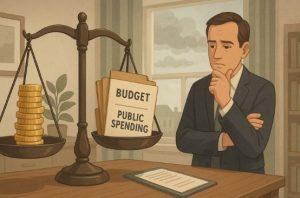The UK’s state pension plays a fundamental role in supporting millions of retirees. One of its most critical and often debated components is the state pension triple lock. Introduced in 2010, this mechanism was designed to ensure that the value of state pensions doesn’t fall behind the rising cost of living or wage increases.
But how exactly does the triple lock system function? And why is it such a hot topic in political and financial discussions across the UK? In this guide, we break down the workings of the triple lock, explore its history, assess its impact on pensioners, and evaluate what the future might hold.
What Is the State Pension Triple Lock?

The triple lock is a commitment by the UK government to raise the state pension each year by the highest of three possible figures: the Consumer Price Index (CPI) inflation Under the state pension triple lock, the annual increase is determined by comparing three figures:
the inflation rate (CPI), the average rise in wages across the UK, and a guaranteed minimum of 2.5%. Whichever of these is highest sets the level of increase applied to the state pension in the upcoming financial year.
This policy ensures that pensioners receive an annual increase that keeps pace with the cost of living or average income levels. Whether inflation spikes or wages rise quickly, the triple lock promises pensioners will not be left behind.
This policy covers both the new state pension, introduced in April 2016, and the basic state pension, which applies to those who reached retirement age before that date. However, the actual amount individuals receive depends on their National Insurance (NI) contribution history.
How Does the Triple Lock Mechanism Affect State Pension Increases?
The mechanics of the triple lock are simple in principle but impactful in execution. Each autumn, the government assesses three key figures: CPI inflation from September, average wage growth from July, and the flat 2.5% benchmark. The highest of the three determines how much the state pension will rise the following April.
Here’s a table showing how the triple lock has been applied over recent years:
State Pension Increases Under the Triple Lock (2020–2025)
| Tax Year | CPI Inflation (Sept) | Earnings Growth (July) | 2.5% Guarantee | Applied Increase | Weekly New State Pension |
| 2020/21 | 1.7% | 3.9% | 2.5% | 3.9% (Earnings) | £175.20 |
| 2021/22 | 0.5% | 5.5% (excluded) | 2.5% | 2.5% (Minimum) | £179.60 |
| 2022/23 | 3.1% | 8.3% | 2.5% | 3.1% (CPI) | £185.15 |
| 2023/24 | 10.1% | 6.2% | 2.5% | 10.1% (CPI) | £203.85 |
| 2024/25 | 6.7% | 8.5% | 2.5% | 8.5% (Earnings) | £221.20 |
This structure has meant pensioners enjoy predictable and often generous increases in their income, which is vital amid rising living costs.
How Does the Triple Lock State Pension Increase Affect Retirement Income?
The triple lock state pension increase plays a vital role in shaping the financial outlook for millions of UK retirees. By ensuring that state pensions rise annually by the highest of inflation (CPI), average earnings growth, or a minimum of 2.5%, the triple lock provides a stable and predictable income boost each year.
This system helps pensioners maintain their purchasing power as living costs rise, especially during periods of economic volatility. For many, the annual increase is more than just a percentage.
it represents essential support for everyday expenses such as energy bills, food, and healthcare. As a result, the triple lock has become one of the most valued protections in the UK’s pension policy, particularly for those relying primarily on the state pension in retirement.
Why Was the Triple Lock Introduced in the UK?
Before 2010, pension increases were linked only to price inflation, leading to minimal yearly changes that did not reflect the real cost of living or wage growth. This left many pensioners with shrinking purchasing power, particularly during periods of economic uncertainty.
To combat pensioner poverty and restore public confidence in the state pension system, the coalition government introduced the triple lock. The idea was to create a formula that would guarantee growth in retirement income and keep pace with economic conditions, rather than lag behind them.
Since its introduction, the triple lock has become not just a financial tool but also a political promise, frequently discussed in election campaigns and public debates.
What Is the Role of the Government and the DWP in Managing the Triple Lock?

The Department for Work and Pensions (DWP) is tasked with administering the state pension and ensuring that annual increases are calculated and implemented correctly.
Every year, data from the Office for National Statistics (ONS) is reviewed by the government. This includes the average weekly earnings growth from July and the CPI inflation figure from September. The highest of these, or 2.5%, determines the following April’s state pension rise.
The final decision is usually announced in November, after which the DWP makes the necessary adjustments to pension payments, effective from the start of the new financial year in April.
This system involves both economic judgment and political decision making, particularly in years where one of the indicators is abnormally high or low.
How Does the Triple Lock Impact the Full New State Pension vs the Old State Pension?
While both the new and basic state pensions benefit from the triple lock, there are structural differences in how much pensioners receive depending on when they retired.
For individuals who reach state pension age on or after 6 April 2016, the new state pension applies. To qualify for the full amount £221.20 per week in the 2024/25 tax year you need at least 35 qualifying years of National Insurance contributions.
Meanwhile, those who reached retirement age before that date fall under the basic state pension system, which currently offers up to £169.50 per week, typically requiring 30 qualifying years.
However, many pensioners on the old system may also receive additional pension payments like SERPS, making direct comparisons more complex.
Here’s a breakdown of the differences:
Comparison of Basic vs New State Pension (2024/25)
| Feature | Basic State Pension | New State Pension |
| Weekly Amount (Full Rate) | £169.50 | £221.20 |
| Years of NI Contributions | 30 | 35 |
| Additional Pension (SERPS) | Yes | No |
| Triple Lock Applies | Yes | Yes |
| Applicable To | Retired pre-April 2016 | Retired post-April 2016 |
Understanding which pension you qualify for and how much you’ll receive is crucial for retirement planning, especially if you’re close to pension age.
How Is Inflation Measured and Linked to the Pension Triple Lock?
The Consumer Price Index (CPI) is the official measure of inflation used in the triple lock. The Consumer Price Index (CPI) measures inflation by monitoring how the cost of everyday items and services such as groceries, utilities, fuel, and travel changes over time. It’s one of the key factors in calculating annual pension increases through the triple lock system.
Each September, the ONS publishes the CPI rate, which the government uses as one of the three criteria for setting the pension increase.
If CPI is higher than both average earnings growth and 2.5%, then pensions rise in line with CPI. This happened in 2023/24, when inflation was over 10%, resulting in one of the largest state pension increases in decades.
This inflation link is essential for pensioners, many of whom live on fixed incomes and are especially vulnerable to rising prices for essential items.
What Are the Current Challenges Facing the Triple Lock Guarantee?

Despite its benefits, the triple lock faces growing scrutiny due to its long-term affordability. Rising life expectancy means more people are drawing the state pension for longer periods, and triple lock increases amplify the pressure on public finances.
In the 2021/22 fiscal year, the UK government temporarily removed the earnings component from the triple lock. This was due to an unusual spike in average wages over 8% following the end of pandemic-related job support schemes, which was considered a statistical anomaly.
This move temporarily converted the policy into a double lock, highlighting how volatile economic conditions can influence policy adjustments.
Critics argue that the triple lock:
- Disproportionately benefits older voters
- Contributes to intergenerational inequality
- Makes government budgeting more unpredictable
As a result, there are ongoing discussions about reforming or replacing the system, especially given the UK’s ageing population and tightening fiscal outlook.
What Could Replace the Triple Lock in the Future?
Several alternative models have been proposed to ensure pensioners still receive protection without overstretching public resources. A double lock model removing the 2.5% minimum and using only earnings or inflation has been suggested as a more sustainable option.
Others propose a more dynamic link between pensions and economic productivity, or tying increases solely to CPI inflation. Another idea is to provide targeted top-ups to those most in need via Pension Credit, rather than guaranteeing increases across the board.
Any replacement for the triple lock would need to balance affordability, fairness, and political acceptability a tricky combination for any government.
When Will the Next State Pension Rise Be Announced?
The next increase will be applied in April 2025. The exact percentage will be based on data released in the second half of 2024.
- Average earnings data (July figures) will be released by the ONS in August/September 2024.
- CPI inflation (September) will be published in October 2024.
- The government will confirm the rise in November 2024.
Forecasts suggest the next increase could be around 7%, though this will depend on economic trends in earnings and inflation in the second half of the year.
How Can People Forecast Their Future State Pension?

The easiest way to check your future state pension is through the UK Government’s online forecast tool. By logging in with your Government Gateway ID, you can access:
- The amount you’re likely to receive at retirement
- Your current National Insurance contribution record
- Any shortfalls or gaps you may need to fill
This service is especially useful for people nearing pension age, helping them plan better for retirement or top up their NI contributions if necessary.
Conclusion
The state pension triple lock has become a cornerstone of retirement planning in the UK. It provides confidence to current pensioners that their income will at least keep up with inflation or earnings growth, and often more.
However, with economic uncertainty, public sector borrowing pressures, and a growing retired population, its future is far from guaranteed. Whether it stays, is modified, or replaced entirely, understanding how it works is key to financial security in later life.
FAQs
Is the triple lock guaranteed every year?
No. While it’s government policy, Parliament can suspend or modify it, as happened in 2021 due to post-COVID earnings data distortion.
What if I don’t have enough NI contributions?
You may receive a reduced state pension or be eligible to top up your record by paying voluntary NI contributions.
Does Pension Credit rise with the triple lock?
Not directly. Pension Credit increases are usually tied to CPI, but not guaranteed to follow the triple lock mechanism.
How much will my pension be if I retire in 2025?
It depends on your NI record and the final triple lock increase announced in November 2024. Use the government forecast tool for an estimate.
Why was the triple lock suspended in 2021?
It was temporarily replaced with a double lock because earnings growth was unusually high (8.3%) due to furlough schemes ending.
Are state pensions taxable?
Yes. If your total annual income (including private pensions and other sources) exceeds the personal allowance, it may be subject to income tax.
Will the triple lock exist in 2030?
It’s uncertain. While popular with pensioners, ongoing financial and political pressures may lead to reform or replacement by that time.









Leave feedback about this